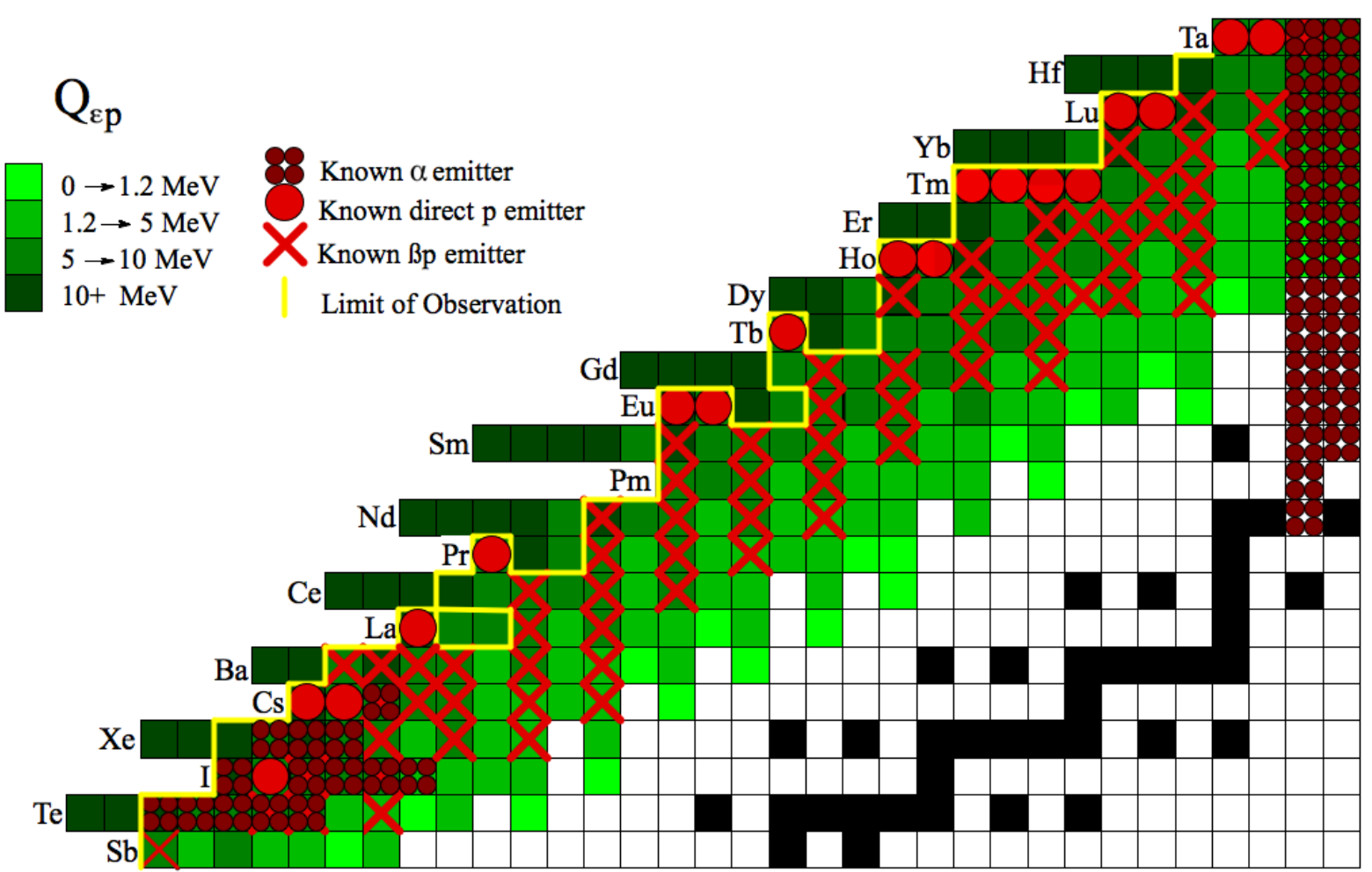Beta+-delayed proton (or α) emission is a typical decay mode of very neutron-deficient nuclei. Valuable information for the ground state in the precursor, such as half-life, spin, and parity, can be obtained by studying the β+-p decay properties. The high efficiency and unique experimental signature for detecting protons allow one to study states in the β+-decay daughter that are not accessible through other means. By measuring the properties of protons emitted to a known state in the daughter, information on the structure of the proton-unbound state can be obtained.
Nuclei near the proton drip line with large Q values for β+ decay often β-decay to excited states that subsequently decay by the emission of a proton. This is known as beta-delayed proton emission (β+-p). It is a typical decay mode of very neutron-deficient nuclei. Valuable information for the ground state in the precursor, such as half-life, spin, and parity, can be obtained by studying the β+-p decay properties. The high efficiency and unique experimental signature for detecting protons allow one to study states in the β+-decay daughter that are not accessible through other means. By measuring the properties of protons emitted to a known state in the daughter, information on the structure of the proton-unbound state can be obtained.
Beta-delayed proton emission is a two step process in which a proton-rich precursor nucleus beta-decays into a state in the emitter that is proton unbound. Proton decay from this unbound state occurs rapidly, so the overall half-life is characteristic of the β decay half-life. This type of decay is energetically possible when the mass of the parent precursor (A, Z) is larger than the mass of the β+-p daughter (A-1, Z-2) plus the mass of the emitted proton. For nuclei that are across the proton drip-line (i.e. the proton separation energy Sp is negative), direct proton emission is a competing decay mode. When emission of a proton is energetically possible, the proton can tunnel through the Coulombic and centrifugal barriers. While the decay rate of β decay changes relatively slowly as the Q-value increases, emission of a proton from an unbound state changes rapidly as the proton energy increases. A similar process exists for β-delayed α emission (β-α). This is illustrated in figure 1 for a precusor nucleus that is slightly proton unbound.

Fig. 1 Schematic of a proton-rich nucleus that is energetically open to direct and β+-delayed proton emission.
Beta-delayed proton emission has been observed from every element from C (Z=6) to Lu (Z=71). For high Z nuclei above N=84 α emission becomes the dominant decay. Figures 2 and 3 graphically show the known β+-p as well as the deduced Qεp values [2] for all known and predicted β+-p emitters.

Fig. 2 Known β+-p emitters and Qεp values [2] for all known and predicted β+-p emitters from C to Sn.

Fig. 3 Known β+-p emitters and Qεp values [2] for all known and predicted β+-p emitters from Sb to Ta.
The known nuclei that exhibit this decay mode are evaluated to give the recommended values for the nuclear properties of these nuclei. This includes branching ratios, and half-lives. In addition for those nuclei with known resolved proton transitions, proton energies, intensities, and the energies of the proton-emitting states are compiled. A list of experimental references for each β+-p precusor is also given in this evaluation. The last evaluations for β+ were published in 1989 [2] and 2008 [3], but these evaluations did not attempt to provide a complete list of emitted proton energies, intensities and populated levels as this evaluation does. There are a total of 200 known β+-delayed particle emitters, organized by their isospin projection are included in this evaluation. Roughly half of these nuclei have updated information that is not in current ENSDF evaluations.
[1]. J. C. Batchelder, Atomic Dat. Nucl. Data Tables 132, 101323 (2020).
[2]. M. Wang, G. Audi, F. G. Kondev, W. J. Huang, S. Naimi, Xing Xu, Chin. Phys. C 41, 030003 (2017).
[3]. J. C. Hardy, E. Hagberg, Particle Emission from Nuclei, Vol. 3, p. 99, CRC Press, Florida (1989).
[4]. B. Blank, M. J. G .Borge, Prog. Part. Nucl. Phys. 60 403 (2008)